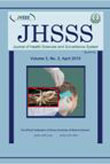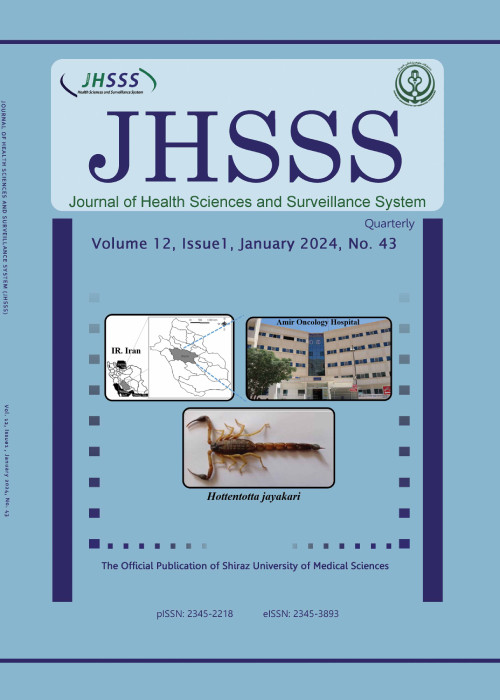فهرست مطالب

Journal of Health Sciences and Surveillance System
Volume:3 Issue: 2, Apr 2015
- تاریخ انتشار: 1394/05/22
- تعداد عناوین: 6
-
-
Page 50BackgroundAlthough it is assumed that calcium has beneficial effects on weight loss, the interaction of calcium and iron would be a major concern. We did this study to investigate the effects of calcium and low-fat milk on serum ferritin in overweight or obese premenopausal women.MethodsSixty-four healthy overweight or obese premenopausal women recruited in Shahid Beheshti University of Medical Sciences clinics participated in this clinical trial. Participants were randomly allocated to one of the following dietary regimens for 8 weeks: 1) a control diet providing a 500 kcal/day deficit, with 500-600mg/day dietary calcium; 2) a calcium- supplemented diet identical to the control diet with 800mg/day calcium carbonate 3) a milk diet providing a 500kcal/day deficit and containing three servings of low fat milk. Serum ferritin and anthropometric indices were measured at baseline and after 8 weeks. Primary outcome measure was serum ferritin level.ResultsMean±SD of baseline values for age, body mass index (BMI), waist circumference (WC), and serum ferritin were 37.44±9.46 (year), 30.79±3.63 (kg/m2), 88.04±8.90 (cm), and 59.20±47.8 (μg/l), respectively. There were no significant differences in baseline age, BMI, WC, and serum ferritin among 3 groups. Mean values of serum ferritin reductions were 0.26±20.36, 14.59±17.07 and6.57±25.93 (μg/l) in control, calcium, and milk groups, respectively. Reduction in serum ferritin was only significant in the calcium group (P=0.003). Serum ferritin reductions were not significantly different among the 3 groups (P=0.260).ConclusionAn energy-restricted diet in combination with calcium supplement or low-fat milk does not induce any additional adverse effect on iron status, compared to an energyrestricted diet alone.Keywords: Calcium, Milk, Iron, Premenopausal, Overweight
-
Page 56BackgroundContamination of water with arsenic has attracted the researchers’ attention as a global problem in recent years and has been observed in some parts of Iran. The purpose of this study is to assess the efficiency of welding iron waste in removing arsenic from aqueous solutions.MethodsIn this study, the effects of different parameters, such as pH (3-9), initial concentration of arsenic (100-3000 μg/l), contact time (5-90min) and adsorbent dose (2.5-20 g/l), were studied. The final concentrations of arsenic were analyzed by atomic absorption.ResultsThe results indicated that at pH=3 and fixed dose of 1 g, arsenic removal efficiency of iron waste was 89.73%. By increasing the pH to 7, the removal efficiency increased to 96.44%. Also, an increase in the amount of iron waste from 2.5 to 10g/l, the removal rate increased from about 42.37% to 96.70%. For contact times of 5 and 30 minutes, the removal rate was 9% and 96.62%, respectively. Then, with increasing the contact time to 90 minutes, the removal rate increased to 99.24%. Correlation coefficient of Freundlich and Langmuir isotherms for As(III) was 0.7593 and 0.9979, respectively.ConclusionThe results of the study showed that welding iron waste has a high potential as an effective, fast and cheap method for removal of arsenate and arsenite from aqueous solutions.Keywords: Iron waste, Arsenite, Aqueous solutions, Arsenic removal
-
Page 64BackgroundsSituation awareness is an important factor in industrial accidents. Improving situation awareness may help to prevent occupational accidents. Determination of factors influencing situation awareness will help to plan and take measures for betterment of working condition and development of a safer workplace. In this study, we examined the role of work overload and job stress in predicting work situation awareness among workers.MethodsThis is a cross-sectional study. A sample consisting of 180 employees in National Petrochemical Company in 2014 was selected using stratified random sampling method; the participants filled out the questionnaires containing questions on demography characteristics, work situation awareness of Sneddon, Mearns & Flin (2013), work overload of Beehr, Walsh & Taber (1976), and job stress scale of Cohen and colleagues (1983).The data were analyzed by SPSS software using coefficient correlation and stepwise regression. Statistical differences were considered significant at P<0.001.ResultsThe results showed that there were internal correlation among work overload, job stress and work situation awareness. Also, the results of stepwise regression analysis revealed that work overload and job stress significantly predicted, respectively, almost 11% and 35% of variances of work situation awareness among workers.ConclusionWork overload and job stress are two main factors for predicting work situation awareness. To improve workplace safety, interventional measures should focus on enhancing the situation awareness via workload and job stress reduction.Keywords: Workload, Psychological stress, Awareness, Occupational health, Workers
-
Page 71BackgroundsIodine deficiency disorder is a major public health problem in areas where there is a lack of iodine in drinking water, soil, and food. This study was carried out to assess the prevalence of goiter among school children in the age group of 6-10 years in Khorramabad city. Also, the level of urine iodine was evaluated.MethodsThe study was conducted from January 2012 to January 2013 in 1125 school children of 6-10 years of age, attending all the schools of Khorramabad city. The subjects were selected through stratified, random, and cluster sampling methods. Their Goiter degrees were evaluated according to WHO classification. Excretory urine iodine was measured based on micrograms per deciliter. Furthermore, the digestion method was used for experimentation.ResultsOut of the 1125 subjects, 866 (77%) had Goiter. 24.2% were diagnosed with Goiter 1a, 45.3% with goiter 1b, and 7.2% with type 2 Goiter. Regarding Goiter, there was no difference between the two sexes. The prevalence of goiter increased with age, but it decreased with the increase of parental educational level. Also, goiter prevalence was lower in families with a higher socioeconomic status. The median urinary iodine was 17.1 micrograms per deciliter, which is desirable in terms of the WHO criterion.ConclusionThe results of the study indicated that using iodizing edible salt to fight with iodine deficiency was effective and helped Khorramabad reach the International indexes of iodine control. Despite this, Khorramabad is one of the hyper- endemic regions in the world.Keywords: Endemic goiter, Prevalence, Students, Urine iodine
-
Page 76BackgroundsAnxiety and depression are found to be the major contributors to irritable bowel syndrome (IBS). The present study aimed to measure the effect of a specifically designed cognitive behavioural therapy (CBT) program on the severity of the symptoms and quality of life of patients with chronic IBS, and also define whether anxiety and depression in patients with IBS at baseline affect their response to CBT.MethodsThe participants were randomly allocated to conventional treatment only (n=25, control) or CBT plus conventional treatment (n=25, intervention) group. The intervention group attended an eight-session group stress management training course conducted by a psychologist in a meeting room at a gastrointestinal clinic at Yasuj University of Medical Sciences. Pre- and post-interventions and 3-month follow-up visits were scheduled and conducted by an experienced healthcare worker to measure the primary outcomes and levels of depression and anxiety in the patients. The study was conducted on 2011.ResultsThe Raw Group Difference (RGD) and Standardised Mean Differences (SMD) for the post treatment scores of the intervention group, when compared with those of the control group, indicated a considerable improvement in the severity of IBS symptoms (RGD=−10.48, SMD=−1.23), anxiety (RGD=−9.90, SMD=−0.725), d epression (RGD=−9.57, SMD=−0.785) a nd patient’s quality of life (MD=−16.81, SMD=−0.469). No association (and interaction with CBT) was found between anxiety/depression at baseline and post-treatment or follow-up scores of the outcomes.ConclusionAlthough CBT improved anxiety, depression, severity of IBS and quality of life of patients with IBS, its effect was independent of the initial level of anxiety and depression of the patients.Keywords: Irritable bowel syndrome, Stress, Anxiety, Quality of life
-
Page 83BackgroundPediculosis capitis is a continuous common health problem worldwide. Pediculus capitis distributes quickly in overcrowded regions. The goal of the present research was to determine some epidemiological features of head lice infestation in Khorram-shahr County, southwestern Iran.MethodsThis descriptive cross-sectional study was conducted on the patients with head lice infestation who referred to the Khorram-shahr Health Center during 2006 to 2009. The gold standard in the diagnosis of infestation was the detection of living nymphs, adults and/or nits on the scalp and hair. After the visual inspections with using a lens and the aid of an ordinary comb, cases were asked to complete a data gathering form containing some questions about demographic and epidemiologic features. The collected information was evaluated using SPSS software, version 11.5.ResultsTotally, 1091 patients were infested with pediculosis capitis. The overall prevalence of head lice infestation during the four- year period was 0.73%. Girls were significantly more infested (87.2%) than boys (12.8%). Pediculosis capitis infestations were highest (46.2%) in subjects aged 6-10 and lowest in those aged less than six (6.4%). The majority of cases lived in the rural areas. The percentage of infestation in rural and urban patients was 59.2% and 40.8%, respectively. Nearly, 11.8% of the patients with head lice had a history of infestation. Most of the cases were found in the Autumn (35.8%).ConclusionGirls were more frequently infested with Pediculus capitis than boys. It can also be concluded that head lice infestation is not highly prevalent in Khorram-shahr.Keywords: Pediculus capitis, Epidemiology, Morbidity, Iran


